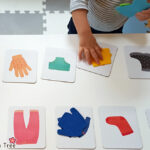Montessori Transferring Activities
Transferring activities are the basis of Montessori pedagogy. They are among the activities toddlers most love.
Transferring means moving something from one container to another and repeating the action over and over. It also involves emptying, filling, spilling, etc. In the Montessori pedagogy, these kinds of activities can be defined as preparatory activities to practical life activities but they are also considered sensory activities.
Daniela Valente, in her book “How to release the potential in your child” explains in detail what decanting means:
“Decanting is a typical activity of the Montessori method, which aims at perfecting the end movement of the hand. It involves decanting a substance, solid or liquid, from one container to another even using tools such as spoons, droppers and the like. Decanting is a preparatory activity to practical life activities, such as eating. Seemingly simple to perform, Montessori decanting encompasses a variety of behaviours and nuances that make it probably one of the most complete activities that stimulates hand-eye coordination and intellectual development. Decanting, which requires self-control and coordination, after repeating exercises and experiments, allows the acquisition of a specific skill in using the hands.”
What are these activities used for?
These activities help babies concentrate, as well as developing their fine motor skills, manual dexterity, self control and hand-eye coordination. Through the process of repeated practice, it allows the child to acquire the specific skills necessary in the use of their hands. Furthermore, the ability to gradually increase the difficulty of an activity, combined with the creativity of using different kinds of materials that can spark your child’s curiosity, are also important features.
We must, of course, first learn to observe our child so that we are able to understand when to introduce a new type of transferring with additional materials, all while studying the child’s reaction. Another important concept is the idea of the control of error. By repeating the transferring activities, children learn to correct themselves while doing the activities, thus eliminating the need for adults to point out mistakes.
Children are very curious by nature and they love to learn new skills and try new tools. Provide them with the opportunity to do so by offering transferring work and you will see that it will hold their attention for some time. They will certainly be very engaged! You can easily do these activities at home, with the materials you have on hand.
It is always a good idea to first try the transferring activity on your own and see if your spoon or scoop is easy to grasp and use. Dried butter beans are easier to start off with but, if you don’t have them, you can also use chickpeas, short pasta, rice, coffee beans, etc..

What are the ages for transferring activities?
A lot of children start to discover the fascination of these activities at a very early age. This usually happens when the child is one years old. Some children may do so at around eighteen months. Our role, as educators, is to observe the child and suggest different types of transferring activities, by creatively using resources that we have on hand. In addition, we gradually increase the difficulty of these activities, which can be used with children up to three years old. It depends on the interest that your child shows.
Starting at the age of three, but perhaps even sooner, children will most certainly be adept at pouring water in their glass using a small carafe. The continuous process of transferring and pouring activity will help them acquire this skill. In addition, they will be able to serve themselves food transferred from a plate to a bowl.
Moreover, as part of her pedagogy, Maria Montessori suggests other types of activities called Practical Life Activities, appropriate for children from the ages of 2,5/3 to 6 years old. I will talk about these activities in a future post.
To learn more about Montessori transferring activities, you may want to read the articles on these popular blogs. It will give you a lot of tips and advice about Montessori transferring and practical life activities.
How We Montessori
First Montessori Transferring Activities – 19 months
Transferring Activities 18 months – 3 years
Living Montessori Now
Favorite Montessori practical life activities for toddlers and preschoolers
I hope this post sparked your curiosity and that you found it helpful in better understanding the idea behind transferring activities and their importance for our children. Don’t miss my next post, where I suggest various types of Montessori-inspired transferring activities that you can easily do at home or at your nursery with your children.
Moreover, in order to have a complete list of tools that you can buy to use in your various transferring activities, I recommend reading my post “TIPS & IDEAS FOR TRANSFERRING ACTIVITIES”.








